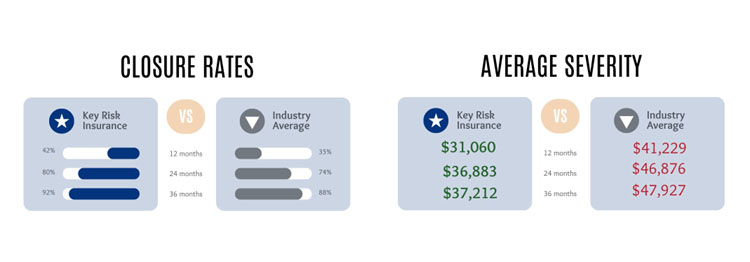The Importance of an Effective Return-to-Work Program in Workers Compensation Insurance

When managing the complexities of workers compensation insurance, there is nothing more important than an effective return-to-work program. With employees being an organization’s number one asset, having options for their safe and quick return to work is paramount to avoid business disruption. Even more importantly, supporting employees’ return to work enhances their buy-in and sense of value. Ensuring your business has a process in place for returning employees to work is critical for both the employee and the organization: rates of return to a pre-injury job drop from 92.2% within the first 12 weeks post-incident to 55.4% at 13 weeks and beyond.
Key Risk is relentlessly focused on returning injured employees to work, as shown in our results. Compared to the industry average, we close claims 20% faster and at 25% lower cost than the industry, ensuring your business operation is minimally impacted.
The success of our streamlined return-to-work program emphasizes close working relationships between our agents and insureds, prioritizing an expedient and effective path back to work.
There are a few key elements to a strong return-to-work program, first and most important of which is leadership commitment and a safety culture that permeates throughout the organization. Having leaders who truly prioritize safety and the value of getting people back to work quickly is essential. This sets the tone for the rest of the organization and engages employees at all levels of the organization.
The second is developing a formal written program. A formal program includes written procedures for reporting a claim, the timeframe to do so, the expectations of the employee, the return-to-work policy, and any procedures the managers and employees need to follow when an incident occurs. Having this in writing and understood at all levels provides clear expectations and processes.
Equally important is the implementation of formal job descriptions for all employees. When a claim occurs and a doctor is assessing return-to-work capabilities, we need to be sure we can provide the doctor with a solid understanding of what is required of the injured employee, including what their full job duties entail and the level of activity required for the position. This ensures that even if someone is given restrictions, they may fall within their normal duty job, which is why having the full job description is necessary.
Lastly, employers must adopt thoughtful and inclusive hiring practices to find individuals who align with the company culture. Additionally, this should be accompanied by comprehensive onboarding procedures that fully orient employees to the organization’s practices and standards. Even if you have a formal written program, if it is not engrained in your employees when they are being hired and onboarded, then it will not have the effect needed to be successful.
Having a successful return-to-work program is the critical foundation for ensuring smooth operations. Still, it requires coordination and collaboration across the team to execute once an injury occurs. This requires the claims professional, the employer, and the employee to communicate efficiently. For the claims professional, it is all about quick and thorough contact with all parties, prioritizing explaining the process and expectations clearly to the injured worker. This is likely the first time this person has had a workplace injury, so being very intentional in explaining how the process works, as well as expectations surrounding communication, return-to-work, and medical updates are the keys to success. For the employer, it starts with reporting the claim right away, discussing the return-to-work options with the employee in a timely manner, and setting expectations on the level of communication needed throughout the process. Above all, employers must emphasize the value and care they have for the injured worker. Regularly checking in to see how they are doing and assuring them that they have a job to return to are paramount in a successful return-to-work scenario.
A comprehensive and effective return-to-work program allows businesses to run with minimal disruptions and yields better outcomes for both employers and employees. It benefits the total cost of risk and experience modification in the short-term, as well as employee retention and growth long-term.
